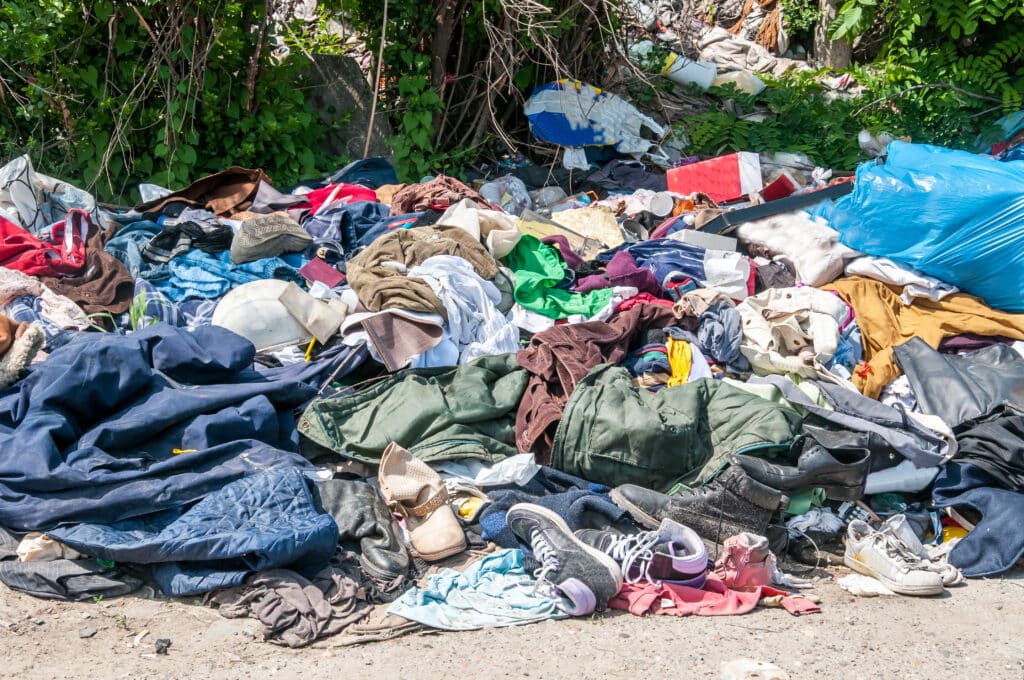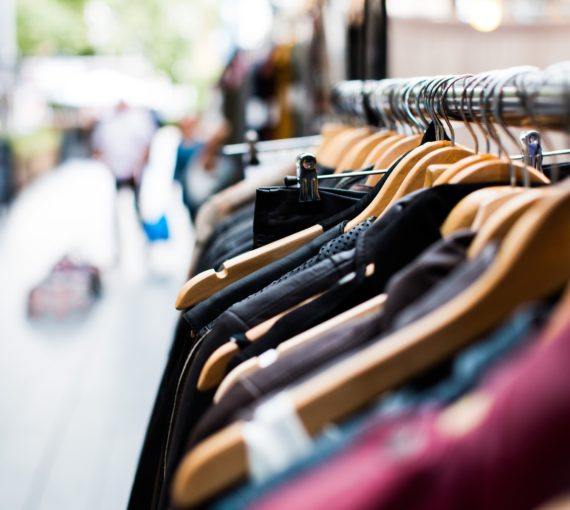
Fast fashion is bad for the environment. Many discarded items end up in landfills. And they’re often made from synthetic materials that don’t biodegrade.
We live in a “throw away” culture — from clothing to coffee cups. But nothing we produce is ever truly gone. It either returns to nature or pollutes. The fast fashion industry, driven by low costs and quick trends, shows how the planet pays the price — from overflowing landfills, water use and chemical run-off to climate-altering carbon emissions and microplastics.
The New York Times first coined “fast fashion” in the 1990s. It describes how quickly retailers take products from design to stores. Now it’s used in conversations about fashion industry sustainability.
Spot fast fashion industry greenwashing and refresh your wardrobe with affordable, sustainable alternatives.
From runway to landfill: fast fashion environmental impacts
Many clothing producers have design-to-customer pipelines tailored to pump out cheaply produced and priced garments that capitalize quickly on current fashion trends. The problem? Styles are changing faster than ever, increasing supply and demand pressures. Worldwide, people consume 80 billon new pieces of clothing every year — a 400 per cent increase from 20 years ago! Though the clothing costs less, the environment ultimately pays the price.
Water use and chemical run-off
According to the UN Environment Programme, the fashion industry is Earth’s second-largest water consumer (agriculture leads). It uses 93 billion cubic metres of water, enough to meet the consumption needs of five million people. Wastewater and chemical run-off from textile factories pollute water sources and soil surrounding factories. About 20 percent of wastewater worldwide is from dyeing textiles. It’s extremely toxic. Often no treatment can make it safe again.
The world witnessed the scale of this water crisis in Dhaka, the capital of Bangladesh. Flooding created fast-moving rivers and canals turned black from wastewater full of toxic chemical dyes. Dhaka is the world’s second biggest garment manufacturing hub. It’s one of the most climate vulnerable cities on Earth.
Carbon emissions
The fashion industry is responsible for eight to 10 per cent of global emissions. That’s more than the aviation and shipping industry combined! At this pace, fashion emissions will surge by more than 50 per cent in 2030.
Making plastic fibres into textiles (e.g., polyester, nylon, polyamide, acrylic, etc.) is energy-intensive and relies on large quantities of fossil fuels. Production emits huge quantities of carbon and volatile particulate matter and acids like hydrogen chloride.
Transporting fast fashion garments also uses a lot of energy and creates carbon emissions. The global supply chain means products are shipped long distances, often on freight ships and planes.
Microplastics
Many fast fashion brands use synthetic, non-biodegradable fibres such as nylon, polyester and acrylic. A 2017 study reported that about 35 per cent of all microplastics in the ocean come from washing synthetic textiles. Microplastics harm marine ecosystems, aquatic life and human health.

We're living in a plastic world
Almost every product and material we refer to as “plastic” is made from fossil fuels. Most of it hasn’t been around for long — a little over 70 years for the most common products.
Landfilling
Fast turnover of trends and fast fashion affordability have created a destructive buy-throw-away cycle. It leads to enormous textile waste. Many discarded garments end up in landfills. They’re often made from synthetic materials that don’t biodegrade. Almost 87 per cent of total fibre input used for clothing is burned or ends up in a landfill. No recycling and landfilling clothes before they’re even sold costs the industry $500 billion dollars of value every year.
FAST FASHION FACTS
25 per cent
of new garments remain unsold. As much as 12 per cent of fibres are discarded on the factory floor.
3,500
chemicals are used in textile production. Ten per cent of these are hazardous to human health. Five per cent are hazardous to the environment.
35 per cent
of primary microplastics in the ocean are from washing synthetic textiles. These release 0.5 billion kilograms of microplastic fibres into the ocean each year.
Source: Greenpeace, Greenwash Danger Zone
Fast fashion: ethical considerations
Fast fashion raises questions around labour practices, human rights and social impacts.
- Exploitation of labour. Fast fashion brands are criticized for exploiting cheap labour in developing countries. Workers often face low wages, poor working conditions and long, unregulated hours. They may lack job security, unions and basic labour rights.
- Exploitation of child labour. These businesses rely on the poorest people and target underprivileged children caught in the cycle of poverty. A survey conducted in a textile mill in India found that 60 per cent of employees were under the age of 18 when they began working.
- Unsafe working conditions. Many factories rank low costs over safety, risking workers’ lives. The 2013 Rana Plaza collapse in Bangladesh caused 1,100 deaths.
- Exposure to toxic chemicals. Thousands of synthetic chemicals are used to produce fast fashion. Factory workers are exposed to and inhale chemicals known to cause cancer. Racialized workers exposed to higher levels of toxic chemical exposure is environmental racism.
What fast fashion brands are the worst offenders?
Chinese-based retail giant Shein is an online-only global fashion behemoth. Its environmental and human health impacts are grave.
It’s one of the largest, most popular companies in the world. Its $66- billion valuation represents more than one-third of the U.S. fast fashion market. It’s especially popular with Gen Z because it keeps up with trends — adding 10,000 new items to its inventory every day! It connects with youth through strategic influencer marketing campaigns and keeps prices low. Shein’s influence and power is immense — as are its environmental impacts and ethical concerns.
The company emits about 6.3 billion kilograms of carbon dioxide each year. That’s equivalent to 180 coal-fired power plants. Most of Shein’s products are made of plastic, synthetic fibres and toxic chemical dyes. Scientists found that a Shein jacket meant for toddlers contained almost 20 times the amount of lead Health Canada considers safe for children.
Shein has also been under scrutiny for terrible working conditions, stealing independent artists’ designs (resulting in a federal racketeering lawsuit), sale of offensive items and mishandling of customer data.
They’re not the only offenders. Hundreds of brands and companies contribute to the fast fashion problem. Six others with the worst environmental records are Zara, H&M, Forever 21, Uniqlo, Mango and ASOS.

Unpack the environmental impacts of online shopping
Online shopping can boast some environmental benefits. But it’s complicated… Overconsumption, packaging, transportation, returns and disposability are all part of the systems and culture of online shopping. That calls for better balance between modern convenience and sustainability.
Beware of greenwashing
As more people become eco-conscious, more fashion brands see that sustainability sells.
Some clothing retailers are reducing their environmental impacts. They’re using sustainable materials more, reducing waste and improving supply chain practices. Others are deceiving customers with false or inaccurate claims. Do consumer research. Learn how to spot greenwashing.
Greenwashing refers to marketing that makes environmental and/or social responsibility claims to mask harmful and/or unethical practices. These tactics aim to attract or maintain eco-conscious customers and/or falsely improve a company’s image.
A screening of fashion industry sustainability claims suggested that 39 per cent could be false or deceptive. Big fast fashion brands like H&M, Zara, Uniqlo, Nike and Allbirds have been called out for greenwashing.
What to look out for if you suspect greenwashing:
- Vague or unsubstantiated claims. Companies may say their products are “eco-friendly,” “green,” “natural,” or “sustainable” without specific details. This was the basis of the 2022 class action lawsuit against H&M.
- Misleading imagery. Some use images of nature, greenery or eco-friendly symbols in advertising and branding. This creates an impression of environmental responsibility when core business practices are unsustainable.
- Token sustainable products. Fast fashion brands may introduce a small line of eco-friendly products while continuing to use unsustainable production methods. This creates the illusion of a commitment to sustainability.
- Lack of transparency. Does the company disclose information about supply chain practices, sourcing, labour conditions or environmental impacts? You can’t assess a company’s true sustainability efforts without those.
- Unsupported certifications. Some certifications may not have rigorous standards. Others may be outright lies.
To avoid falling for greenwashing tactics:
- Research. Investigate the company’s claims, practices and sustainability reputation. Look for transparent, verifiable information.
- Check certifications. Verify the legitimacy of environmental certifications used by the brand. Better Cotton Initiative (BCI) and The Global Organic Textile Standard (GOTS) are examples of vetted certifications.
- Support sustainable brands. Buy from brands that share your values. Look for demonstrated, long-term commitment to sustainability and ethical practices. Let retailers and manufacturers know what you want.
Informed consumers who advocate for transparency help hold fast fashion companies and brands accountable.

How and why to shop thrift and consignment stores
As consumers, we can make a conscious choice to curb our consumption by using thrift and consignment options. It helps contribute to a circular economy. Plus, who doesn’t love a treasure hunt? Everything you need has likely already been created!
How to tell if a brand is fast fashion
Get to know the characteristics and practices commonly associated with the fast fashion business model.
Unsure? Ask yourself these questions:
- Pricing: Does the brand offer clothing and accessories at exceptionally low prices, often with frequent sales and discounts?
- Rapid inventory turnover: Does the brand frequently release new collections of styles, often on a weekly or even daily basis, to keep up with the latest trends?
- Imitation of trends: Does the brand replicate popular runway, designer or social media trends quickly and offer them at a fraction of the price?
- Low-quality materials: Are the materials used lower quality or synthetic fibres?
- Labour practices: Is there evidence or reports of poor labour practices in the brand’s supply chain? These may include low wages, unsafe working conditions and exploitation of workers.
- Environmental impact or sustainability efforts: Is the brand transparent about its environmental practices? Does it market itself as “green” or “eco-friendly” without concrete evidence?
- Outsourced manufacturing: Is the brand mostly produced in countries known for loose labour and environmental regulations?
- Lack of transparency: Does the brand hide details about its supply chain, sourcing and labour practices? Does it make it difficult for you to assess its ethical and environmental commitments?
How to shop affordably without fast fashion
Fast fashion affordability is appealing. Many people feel the cost-of-living crisis, financial insecurity and rising inflation on essential goods (including clothing). This may mean making sacrifices to meet basic needs. But you don’t have to sacrifice your values to be fashion eco-conscious.
Some strategies to find affordability and sustainability balance:
- Buy less and choose quality. Invest in a smaller number of high-quality, versatile clothing items that will last longer. Although these may be more expensive upfront, they may be more cost-effective in the long run and have a lower environmental impact.
- Shop second-hand and thrift. Thrifting, consigning and buying second-hand clothing is affordable and eco-friendly. It extends the life of existing clothing. It contributes to a circular economy. It reduces demand for new, mass-produced items.
- Host a clothing swap. Make it a habit to declutter every season and host a clothing swap. You’ll refresh your wardrobe and get items you’re not wearing into the hands of someone who will.
- Repair and upcycle. Learn basic sewing and mending skills to repair damaged clothing. Consider upcycling old clothing into new pieces to give them a second life. Turn unsalvageable clothing into rags, quilting squares or art projects!
- Take care of your clothes. They’ll last longer. You’ll pollute less.
- Build a capsule wardrobe. Some 40 per cent of clothing bought is never worn! Choose 10 to 20 versatile, high-quality, durable items that can be mixed and matched.
- Rent or borrow. For special occasions or one-time events, rent clothing or borrow from friends and family.
- Embrace slow fashion. This movement advocates for environmental and social justice. Support retailers that proudly display and align with your values.
Balancing affordability and sustainability can be challenging at first. But making small, intentional changes in your shopping habits can have a positive impact on your wallet and the environment.



